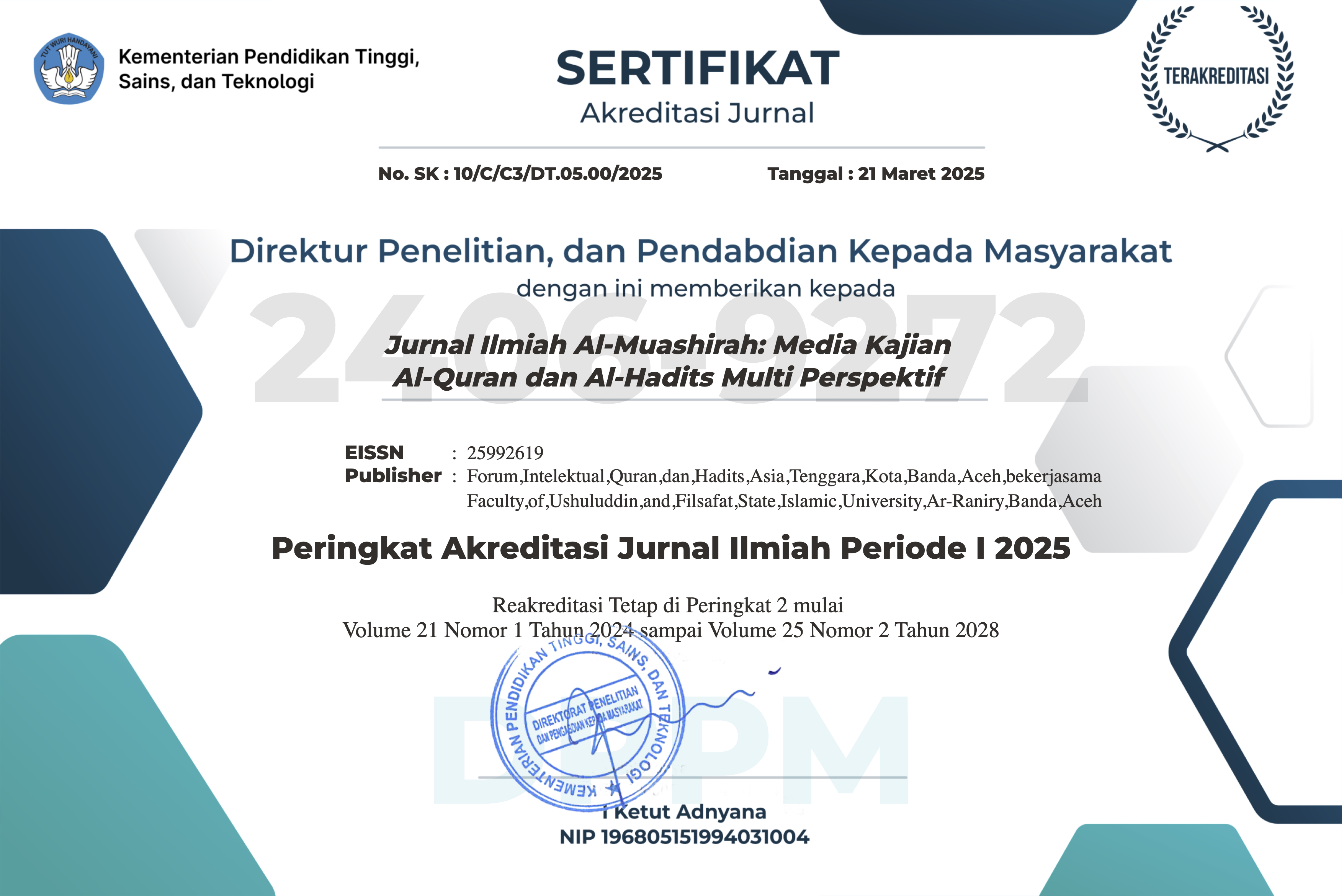Qur’anic Therapeutic Spiritual Communication for Students Involved in Cyberbullying from Broken Home Families
DOI:
https://doi.org/10.22373/jim.v22i1.29608Keywords:
Qur’anic-Based, Cyberbullying Impact, Therapeutic Spiritual Communication, Broken Home FamiliesAbstract
This study explores the delivery of Qur’anic spiritual messages by Islamic Education teachers to students from broken home families who are either victims or perpetrators of cyberbullying. The aim is to foster awareness of the importance of ethical interaction on social media and to develop emotional, mental, and spiritual resilience. Employing a qualitative case study approach, the research involved four Islamic Education teachers, two homeroom teachers, and five students from broken home backgrounds. Data were collected through observation and interviews, and analyzed using data reduction, data display, verification, and conclusion drawing. The findings reveal that a broken home environment can trigger students to become both victims and perpetrators of cyberbullying. As victims, students are at risk of psychological, emotional, and mental distress. As perpetrators, they may experience moral degradation and diminished humanity. The study concludes that the harmful effects of cyberbullying on students from broken home families can be mitigated through the therapeutic stimulation of Qur’anic spiritual messages, focusing on moral conduct, life principles, repentance, patience, and positive thinking.
Downloads
References
Abu Zakaria Muhyiddin an-Nawawi, Riyadh As-Shalihin (Darul Fikri, 2023)
Adawiyah, Siti, and Uus Kusnadi, ‘Dampak Workaholic Parents Terhadap Perkembangan Moral Anak’, Trihayu: Jurnal Pendidikan Ke-SD-An, 10.1 (2023), pp. 1–10, doi:https://doi.org/10.30738/trihayu.v10i1.14958
AF, ‘Interview with Student’, 22 September 2024
Ah. Yusuf, Kebutuhan Spiritual; Konsep Dan Aplikasi Dalam Asuhan Keperawatan (Wacana Media, 2017)
Aisyah, Siti Hikmatul, Khoridatul Bahiyah, Benny Prasetiya, and Dahani Kusumawati, ‘Dampak Psikologi Terhadap Kehidupan Anak Korban Broken Home’, Al-ATHFAL: Jurnal Pendidikan Anak, 3.2 (2022), pp. 75–81, doi:10.46773/alathfal.v3i2.485
Al-Marâgî, Ahmad Musthafâ, Tafsîr Al-Marâgî, juz 30 (Musthafa Babi al Halabî, 2017)
Andriyani, Hesti, Idham Irwansyah Idrus, and Firdaus W Suhaeb, ‘Fenomena Perilaku Bullying Di Lingkungan Pendidikan’, Jurnal Ilmiah Profesi Pendidikan, 9.2 (2024), pp. 1298–1303, doi:10.29303/jipp.v9i2.2176
Annisah Rachmayanti dan Yuli Candrasari, ‘Perilaku Cyberbullying Di Instagram’, Linimasa: Jurnal Ilmu Komunikasi, 5.1 (2022), pp. 1–12, doi:https://doi.org/10.23969/linimasa.v5i1.4291
Az-Zuhaili, Wahbah, Tafsir Al-Munir: Aqidah, Syari’ah, Dan Manhaj (Gema Insani Press, 2013)
BA, ‘Interview with Student.’, 27 September 2024
Baharuddin, ‘Pengaruh Komunikasi Orang Tua Terhadap Perilaku Anak Pada MIN I Lamno Desa Pante Keutapang Aceh Jaya’, Jurnal Al-Ijtimaiyyah: Media Kajian Pengembangan Masyarakat Islam, 5.1 (2019), pp. 105–23, doi:DOI: http://dx.doi.org/10.22373/al-ijtimaiyyah.v5i1.4207
Creswell, J.W., Research Design: Qualitative, Quantitative and Mixed Methods Approaches (Fourth Edi) (Sage Publications, Inc., 2014)
Delby, Robert Thornberg dan Hanna, ‘How Do Secondary School Students Explain Bullying?’, Educational Research, Vol. 61, N (2019), pp. 148–49
Denanda, Natasya Pazha, Resa Nikmatul Laila, Fitria Rismaningtyas, Natasya Pazha Denanda, Resa Nikmatul Laila, and Fitria Rismaningtyas, ‘PRAKTIK SOSIAL CYBER BULLYING’, Jurnal Analisa Sosiologi, 10.(Edisi Khusus) (2021), pp. 76–94
Devasari, Amelia Ayu, Arwinda Diniati Arwinda Diniati, and Azizah Isnaini Istiqomah Azizah Isnaini Istiqomah, ‘Cyberbullying Pada Aplikasi Media Sosial Tiktok’, Empati : Jurnal Bimbingan Dan Konseling, 9.2 (2022), pp. 156–65, doi:10.26877/empati.v9i2.11072
et al., Anshori, ‘Fenomena Cyberbullying Dalam Kehidupan Remaja’, ABDIMAS (Jurnal Pengabdian Kepada Masyarakat), 4.1 (2022)
Farzana Parveen, Prof Shahina Maqbool, and Dr. Shah Mohd Khan, ‘Optimism as Predictor of Psychological Well Being among Adolescents’, International Journal of Indian Psychology, 3.4 (2016), doi:10.25215/0304.154
Fernández-Castillo, Antonio, Helena Chacón-López, and María J. Fernández-Prados, ‘Self-Esteem and Resilience in Students of Teaching: Evolution Associated with Academic Progress’, Education Research International, 2022 (2022), doi:10.1155/2022/4854332
Gómez-Ortiz, Olga, Eva María Romera, and Rosario Ortega-Ruiz, “Parenting Styles and Bullying. The Mediating Role of Parental Psychological Aggression and Physical Punishment,” Child Abuse & Neglect, 51 (January 2016): 132–43, https://doi.org/10.1016/j.chiabu.2015.10.025.
Hafiza, Sarah, and Marty Mawarpury, ‘Pemaknaan Kebahagiaan Oleh Remaja Broken Home’, Psympathic : Jurnal Ilmiah Psikologi, 5.1 (2018), pp. 59–66, doi:10.15575/psy.v5i1.1956
Hanifah, Razita, and Nur Aini Farida, ‘Peran Keluarga Dalam Mengoptimalkan Perkembangan Anak’, Az-Zakiy: Journal of Islamic Studies, 1.01 (2023), pp. 23–33, doi:10.35706/azzakiy.v1i01.9951
Hasmarlin, Hanum, and Hirmaningsih Hirmaningsih, ‘Self-Compassion Dan Regulasi Emosi Pada Remaja’, Jurnal Psikologi, 15.2 (2019), p. 148, doi:10.24014/jp.v15i2.7740
Imran Arifin, Penelitian Kualitatif Dalam Bidang Ilmu-Ilmu Sosial Dan Keagamaan (Kalimasanda, 1994)
Ismiati, ‘Dampak Pola Asuh Toxic Parents Terhadap Perkembangan Self Esteem Remaja The Impact of Toxic Parents’ Parenting Patterns on the Development of Adolescent Self-Esteem Dampak Pola Asuh Toxic Parents Terhadap Perkembangan Self Esteem Remaja’, 13.1 (2024), pp. 1–14, doi:10.22373/Takamul.v13i1.24781
Jinan, Naurah, Nurul Athirah Mardhiah Mohmed Yusof, Vasantha Vellasamy, Aiman Ahmad, Mohd Nazri Bin Abdul Rahman, and Saeid Motevalli, ‘Review of Parenting Styles and Their Impact on The Adolescents’ Self-Esteem’, International Journal of Academic Research in Progressive Education and Development, 11.2 (2022), doi:10.6007/ijarped/v11-i2/12202
Juvonen, Jaana, Sandra Graham, and ..., 'Bullying in Schools: The Power of Bullies and the Plight of Victims,' Annual Review of Psychology 65.1 (January 3, 2014), pp. 159–85, https://doi.org/10.1146/annurev-psych-010213-115030.
Khotimah, Khusnul, and Retno Wahyuningsih, ‘Hubungan Antara Tingkat Kesibukan Orang Tua Dan Kecenderungan Memilih Teman Sebaya Dalam Pengembangan Akhlak Siswa Madrasah Ibidaiyah’, Cendekia, 14.2 (2020), pp. 13–16, doi:10.30957/ Cendekia. v14i2.640.Hubungan
Kristina, Ni Luh Ayu Widyarina Safira, and Aryani Tri Wrastari, ‘Dinamika Konsep Diri Remaja Dengan Orang Tua Bercerai Berdasarkan Usia Remaja Ketika Perceraian Terjadi’, Buletin Riset Psikologi Dan Kesehatan Mental (BRPKM), 1.2 (2021), pp. 1253–62, doi:10.20473/brpkm.v1i2.28703
Lestari, Windy Sartika, ‘Analisis Faktor-Faktor Penyebab Bullying Di Kalangan Peserta Didik (Studi Kasus Pada Siswa Smpn 2 Kota Tangerang Selatan)’, ANALISIS FAKTOR-FAKTOR PENYEBAB BULLYING DI KALANGAN PESERTA DIDIK Windy, 3.2 (2016), pp. 147–57, doi:10.15408/sd.v3i2.4385.Permalink/DOI
Lexy. J. Moleong, Metodologi Penelitian Kualitatif (PT Remaja Rosdakarya, 2022)
Maya Tanjung, Saydina, Susilawati Siregar, Jirza Raisa Fahira, Arif Zidansyah, and Diky Syahputra, ‘Kurangnya Komunikasi Interpersonal Orang Tua Pada Anak Memicu Terjadinya Kenakalan Remaja Di Desa Pisang Pala Kecamatan Galang’, AL-BALAGH: Jurnal Komunikasi Islam, 6.1 (2022), pp. 1–9, doi:DOI : 10.37064/ab.jki.v6i1.12632
Miles dan Huberman, Analisis Data Kualitatif (Universitas Indonesia, 2014)
Millenium, Bilgis Bayuti Anugera, and Elia Flurentin, ‘Profil Perilaku Cyberbullying Pada Remaja Dan Implikasinya Terhadap Layanan Bimbingan Dan Konseling’, Journal of Innovation and Teacher Professionalism, 2.2 (2024), pp. 171–83, doi:10.17977/um084v2i22024p171-183
Muhibuddin, ‘Hambatan Dan Kegagalan Komunikasi Keluarga Antara Orang Tua Dan Anak ( Komunikasi Efektif Dalam Perspektif Islam Dan Psikologi )’, Jurnal An-Nasyr: Jurnal Dakwah Dalam Mata Tinta, 11.2 (2024), pp. 165–80, doi:DOI: https://doi.org/10.54621/jn.v11i2.920
Navarro, Raúl et al., “Families, Parenting and Aggressive Preschoolers: A Scoping Review of Studies Examining Family Variables Related to Preschool Aggression,” International Journal of Environmental Research and Public Health 19.23 (2022): 15556, https://doi.org/10.3390/ijerph192315556
NR, ‘Interview with Student.’, 22 September 2024
Pratama, Aunillah Reza, and Wildan Hidayat, ‘Fenomena Bullying Perspektif Hadits’, DIALOGIA JURNAL STUDI ISLAM DAN SOSIAL, 16.2 (2018), pp. 177–78 <https://doi.org/10.21154/dialogia.v16i2.1502>
Purnomo, Safira Debby Quisthosa, and Abdul Hakim Zakkiy Fasya, ‘Gambaran Kejadian Cyberbullying Pada Remaja Cyberbullying Among Teenagers’, Jurnal Ilmu Kesehatan, 6.2 (2022), pp. 333–38, doi:http://dx.doi.org/10.33757/jik.v6i2.564
Rahman Wahid, Yusuf Tri Herlambang, Ani Hendrayani, and Sigit Vebrianto Susilo, ‘Dampak Keluarga Broken Home Terhadap Perubahan Kepribadian Anak Usia Sekolah Dasar’, Jurnal Cakrawala Pendas, 8.4 (2022), pp. 1626–33, doi:10.31949/jcp.v8i4.2397
Riswanto, Dody, and Rahmiwati Marsinun, ‘Perilaku Cyberbullying Remaja Di Media Sosial’, Analitika, 12.2 (2020), pp. 98–111, doi:10.31289/analitika.v12i2.3704
Safaria, Triantoro, and Irfani Rizal, ‘Extraversion, Secure Attachment, Dan Perilaku Cyberbullying’, Jurnal Psikologi Sosial, 17.02 (2019), pp. 96–103, doi:10.7454/jps.2019.13
Sanusi, Hafifa Zuhra, and Mohamad Syahriar Sugandi, ‘Peran Komunikasi Keluarga Dalam Perilaku Cyberbullying Pada Remaja’, Ettisal: Journal of Communication, 5.2 (2020), pp. 273–89, doi:http://dx.doi.org/10.21111/ejoc.v5i2.4440
Sayid Quthub, Tafsir Fi Zhilal Al-Qur’an (Dar asy-Syuruq, 1992)
Setiawan, Arif Adi, ‘Pengembangan Terapi Holistic Nursing Berbasis Islamic Spiritual Practice Dalam Mengurangi Kecemasan Pada Klien Dengan Acute Coronary Syndrome’, in Proceeding Seminar Ilmiah Keperawatan 3rd Adult Nursing Practice: Using Evidence in Care "Holistic Nursing in Emergency and Distarter: Issue and Future (Fakultas Kedokteran Universitas Diponegoro, 2015)
Shihab, M. Quraish, Tafsir Al-Mishbah; Pesan Kesan Dan Keserasian Al-Quran, Jilid 8 (Lentera Hati, 2013)
Shinta Rahma Nata Sari, et al., ‘Gambaran Perilaku Cyberbullying Pada Remaja Di SMAN Pekanbaru’, Jurnal Keperawatan Sriwijaya, 7.2 (2020), pp. 16–24, doi:10.32539/JKS.v7i2.15240
SHU, ‘Interview with Student.’, 27 September 2024
Soutter, Anne Kathryn, Billy O’Steen, and Alison Gilmore, ‘The Student Well-Being Model: A Conceptual Framework for the Development of Student Well-Being Indicators’, International Journal of Adolescence and Youth, 19.4 (2014), pp. 496–520, doi:10.1080/02673843.2012.754362
Sudaryono, Metode Penelitian Pendidikan (Kencana, 2016)
Sugiyono, Metode Penelitian Kuantitatif, Kualitatif, Dan R&D (Alfabeta, 2019)
SW, ‘Interview with Student’, 22 September 2024
Syamsuri, Menina Vilanova, and Suksmi Yitnamurti, ‘Perselingkuhan Dalam Sudut Pandang Psikiatri’, Jurnal Psikiatri Surabaya, 6.1 (2017), pp. 50–57, doi:https://doi.org/10.20473/jps.v6i1.19101
Tordjman, S. 'School Bullying and Group Violence: How to Occupy a Place in the Group by Exclusion,' L’Encéphale 48 (September 2022), pp. 19–29, https://doi.org/10.1016/ j.encep.2022.08.002
United Nations Children’s Fund (UNICEF), ‘Situasi Anak Di Indonesia - Tren, Peluang, Dan Tantangan Dalam Memenuhi Hak-Hak Anak’, Unicef Indonesia, 2020, pp. 8–38
Verseveld, M Van and M Fekkes, 'Bullying and Mental Health: The Effects of Prima Anti-Bullying Program in The Netherlands,' European Journal of Public Health, 28(suppl_4) (2018), https://doi.org/10.1093/eurpub/cky213.057
Wulandah, Safirah, and Safirah Wulandah, ‘FENOMENA CYBERBULLYING : KRISIS ETIKA KOMUNIKASI NETIZEN PADA MEDIA SOSIAL’, Jurnal Analisa Sosilogi, 12.2 (2023), pp. 387–409
Wulandari, Ratna, and Nur Hidayah, ‘Analisis Strategi Regulasi Emosi Cognitive Reappraisal Untuk Menurunkan Perilaku Cyberbullying’, Indonesian Journal of Educational Counseling, 2.2 (2018), pp. 143–50, doi:10.30653/001.201822.27
Zakiyah, Ela Zain, Sahadi Humaedi, and Meilanny Budiarti Santoso, ‘Faktor Yang Mempengaruhi Remaja Dalam Melakukan Bullying’, Prosiding Penelitian Dan Pengabdian Kepada Masyarakat, 4.2 (2017), pp. 324–30, doi:10.24198/jppm.v4i2.14352
Mr F, ‘Interview with Islamic Education Teacher’, 3 October 2024
Mr M, ‘Interview with Islamic Education Teacher’, 3 October 2024
Mrs. AR, ‘Interview with Homeroom Teacher’, 22 September 2024
Mrs. H, ‘Interview with Islamic Education Teacher’, 3 October 2024
Mrs E, ‘Interview with Islamic Education Teacher’, 3 October 2024
Mrs EE, ‘Interview with Homeroom Teacher’, 27 September 2024
Downloads
Published
Issue
Section
License
Copyright (c) 2025 Ahmad Bahrul Hikam, Ahmad Badruddin, Mohamad Zaenal Arifin, Muhammad Amin.

This work is licensed under a Creative Commons Attribution-ShareAlike 4.0 International License.
Authors who publish in Jurnal Ilmiah Al-Mu'ashirah agree to the following terms:
- Authors retain copyright and grant the journal right of first publication with the work simultaneously licensed under a Attribution-ShareAlike 4.0 International (CC BY-SA 4.0) License that allows others to share the work with an acknowledgment of the work's authorship and initial publication in this journal.
- Authors are able to enter into separate, additional contractual arrangements for the non-exclusive distribution of the journal's published version of the work (e.g., post it to an institutional repository or publish it in a book), with an acknowledgment of its initial publication in this journal.
- Authors are permitted and encouraged to post their work online (e.g., in institutional repositories or on their website) prior to and during the submission process, as it can lead to productive exchanges, as well as earlier and greater citation of published work (See The Effect of Open Access).














